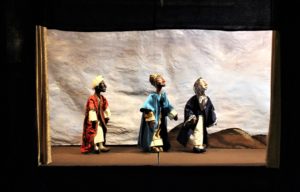 Marionette Nativity show is a throwback that connects with children and adults.
Marionette Nativity show is a throwback that connects with children and adults.
Puppetry as ministry fell out of favor with churches as media and children’s expectations for entertainment became more sophisticated. Many churches now lean toward high energy programs and elaborate stage design that capture modern kid’s attention. Marionette puppetry—puppets controlled by strings–was rarely used in churches and even in mainstream culture it has very nearly disappeared.
But as the world around us has become more technology driven and entertainment saturated many people are nostalgic for simplicity. Witness the popularity of “artisan” and “craft” goods, the resurgence of board games, coloring books for adults, and the renewed interest in icons like Mr. Rogers (who used puppets extensively). There is something wonder-inducing and calming about the simple, wholesome, and handmade.
Tim Taylor, one of the arts ministry leaders at Indy Vineyard church, has always been fascinated with puppetry and particularly with the presentation and mechanics of marionettes. So IVAC, the Indy Vineyard Arts Community, decided to produce a marionette show, a nativity, for the church’s Christmas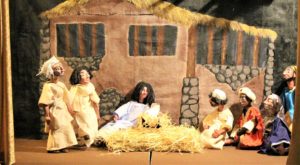 2018 family service.
2018 family service.
Tim designed and built 11 marionettes, the team built a stage and sets, and the night of the show children and adults were transfixed by the charming performance. Afterwards, children flocked to the stage to get a look behind the scenes, touch the puppets, and pull the strings themselves.
Its was a fair bit of work, but the marionette nativity enabled the church to present a very special family Christmas event in a wonderfully whimsical and nostalgic way. And as you’ll see in this “how to” project report, marionette shows have their roots in Christian ministry. Marionette actually means “little Mary,” as in the mother of Jesus.
The Marionette Nativity Show Project
Submitted by Timothy Taylor
Concept: Present a marionette nativity show for a special holiday family service.
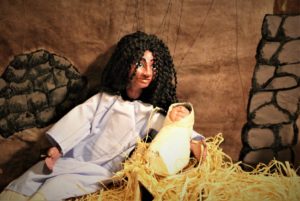
Background: Puppetry has been a lifelong fascination for me, especially marionettes or puppets on strings. While stringed puppets have existed in various cultures for millenia, it was the French who gave them their modern name. In an age of illiteracy, art was a vital means of presenting the gospel to people who could not access the Bible for themselves. Priests often used stringed puppets to tell Bible stories, with the Virgin Mary being the most popular character. Soon, all the puppets were being referred to as “Little Mary” or marionette. Our church has a beautiful blend of ancient and modern traditions, and I thought this forgotten piece of church culture was worth revisiting.
How it Works: While I’d made a multitude of puppets over the years, including some for theatrical productions, I had never created a full-fledged puppet show and stage for performance.
The Marionettes: I chose to create my marionettes (11 in all) out of muslin cloth with heads sculpted from paper mache and paper clay.
The Theater: I also chose to take this opportunity to construct a traditional marionette stage: elevated off the ground, with curtains, backdrop, lights, and elevated

operators’ bridge. (The plans were adapted from The Complete Book of Marionettes.)
The Script: We prerecorded the entire show, which enabled us to focus on operating the puppets during the show. I lifted the text directly from Scripture (the nativity story), and enlisted various friends to play the parts. Woven into this was a selection of Christmas carols. I deliberately chose many carols with French origins. It is necessary to have musical interludes to allow for scene changes.
Result:
The night of the performance there were more adults in the room than children, and after the show, as we parted the curtains and let everyone backstage, young and old alike pressed in to touch the marionettes. Everyone was fascinated with them and there were murmurs of it becoming a regular church tradition. It was certainly a lot of work, but worth it.
Details:
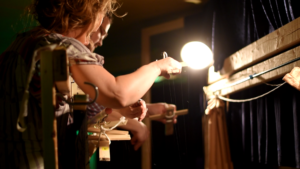
The marionette puppeteers stand above the stage manipulating the puppets. Puppets waiting to be used are hung up the behind the stage. There are generally two puppeteers, a couple of people changing the scene backgrounds and operating the curtains, and someone operating the soundtrack and lighting.
It’s worth perusing the puppet section of your local library or Amazon for books on the subject and tutorials on how to build a puppet. (See Resources below.)
Puppetry is somewhat of a dying art. At one time it was even in jeopardy of being lost altogether, as master puppeteers took their secrets to the grave. Even today many puppeteers rely on books that are decades old for instruction. I’ve included a list of resources I used below.
I opted for a large, complex production. However, if this is daunting, it could easily be simplified.
Marionettes can be made as simple or as complex as you wish. Simple geometric forms, draped in the right fabric can be effectively brought to life with a bit of practice. A suitably limp cloth doll could even be strung to create a marionette. Hand puppets or even two-dimensional shadow puppets could be used to make
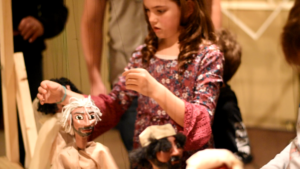
a simple yet beautiful show.
Resources:
OpenLibrary.org has a huge digital selection of out of print puppetry books that can be checked out for free.
The Complete Book of Marionettes by Mabel and Les Beaton is a go-to primer. This book contains the patterns and instructions I used to make the puppets for our show, and the plans for the stage.
Marionettes: Easy to Make, Fun to Use by Edith Flack Ackley is nearly a century old but contains details for making marionettes completely out of cloth if papier mache and paint seem daunting. It also contains instructions for simple stages. My first real marionettes as a kid were made using this book.

Tim Taylor is available for consultation if you are interested in producing a Marionette Nativity. Reach him at:

